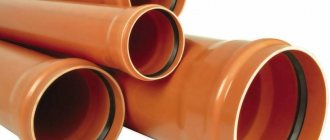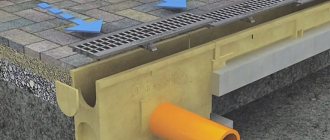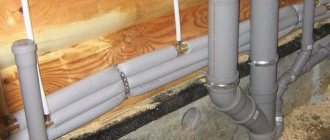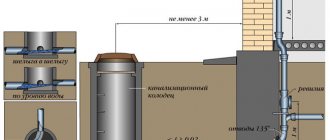The outer and inner diameter of metal pipes.
In the manufacturing process of metal pipes, their outer diameter is taken as a basis. Also, based on the general division of pipes into 3 types, the following applications are possible:
- Small pipes are used to install water supply in apartments.
- Medium-diameter pipes are suitable for installing urban water supply systems. In addition, crude oil is extracted using medium pipes.
- Large diameter pipes are almost always used in the construction of main oil and gas pipelines.
The internal diameter of metal pipes is not standardized according to GOST and is available in different sizes.
To organize the difference in the internal diameter of metal products, a special parameter is used - “conditional bore (Dу)” . This parameter is the minimum internal diameter of the pipe, rounded to the nearest whole number. The value of Dу is designated according to GOST 355-52. To calculate the internal diameter, subtract twice the wall thickness from the external diameter of the pipe.
Steel pipe diameter table
The amplitude of the internal diameters of steel pipes ranges from 0.6 cm to 20 cm.
In addition, the diameter of finished products can be indicated in inches. (1 inch = 2.54 cm)
Water Pipe Size Chart
| Conditional pass | Outside diameter | Pipe wall thickness | Weight of 1 meter of pipes, kg | ||||
| lungs | ordinary | reinforced | lungs | ordinary | reinforced | ||
| 6 | 10,2 | 1,8 | 2,0 | 2,5 | 0,37 | 0,40 | 0,47 |
| 8 | 13,5 | 2,0 | 2,2 | 2,8 | 0,57 | 0,61 | 0,74 |
| 10 | 17,0 | 2,0 | 2,2 | 2,8 | 0,74 | 0,80 | 0,98 |
| 15 | 21,3 | 2,35 | — | — | 1,10 | — | — |
| 15 | 21,3 | 2,5 | 2,8 | 3,2 | 1,16 | 1,28 | — |
| 20 | 26,8 | 2,35 | — | — | 1,42 | — | 1,43 |
| 20 | 26,8 | 2,5 | 2,8 | 3,2 | 1,5 | 1,66 | 1,86 |
| 25 | 33,5 | 2,8 | 3,2 | 4,0 | 2,12 | 2,39 | 2,91 |
| 32 | 42,3 | 2,8 | 3,2 | 4,0 | 2,73 | 3,09 | 3,78 |
| 40 | 48,0 | 3,0 | 3,5 | 4,0 | 3,33 | 3,84 | 4,34 |
| 50 | 60,0 | 3,0 | 3,5 | 4,5 | 4,22 | 4,88 | 6,16 |
| 65 | 75,5 | 3,2 | 4,0 | 4,5 | 5,71 | 7,05 | 7,88 |
| 80 | 88,5 | 3,5 | 4,0 | 4,5 | 7,34 | 8,34 | 9,32 |
| 90 | 101,3 | 3,5 | 4,0 | 4,5 | 8,44 | 9,60 | 10,74 |
| 100 | 114,0 | 4,0 | 4,5 | 5,0 | 10,85 | 12,15 | 13,44 |
| 125 | 140,0 | 4,0 | 4,5 | 5,5 | 13,42 | 15,04 | 18,24 |
| 150 | 165,0 | 4,0 | 4,5 | 5,5 | 15,88 | 17,81 | 21,63 |
Diameters of plastic pipes.
In the modern world, various plastic pipes are most popular: polypropylene, polyethylene, metal-plastic. Most companies that manufacture plastic pipes use their own sizing chart. As a result, when arranging a water supply system, it is better to use components from one manufacturer.
Table of diameters of plastic pipes
Conformity between metric and inch sizes
Knowing the dimensions of a steel plumbing system, you can understand what sizes of plastic elements should be used instead of metal ones. To do this, you need to multiply the inch size by 25.4 (1 inch = 25.4 mm). This will give you the inner diameter of the plastic pipe. Then you should select the type of pipe that is closest in value. In this case, you should choose the size in the upward direction. For example, for a 3/4″ size, when converted to mm, we get 19.05 mm. From the table we see that 2 sizes are located closely: 16.6 mm and 21.2 mm. We choose a larger one, that is, a pipe with an outer diameter of 32 mm.
When going to the store, you don’t have to stock up on calipers or a ruler to select the required size of products. Just read the labeling of plastic water pipes. At first glance, the inscription looks like a meaningless collection of letters and numbers, but it is not so. The markings indicate:
- manufacturer (graphic logo);
- product type;
- nominal pressure (alphanumeric designation starting with PN);
- pipe dimensions in mm (outer Ø x wall thickness);
- operating class;
- maximum operating pressure in MPa;
- regulatory document, for example TU or GOST.
To determine the correspondence between metric and inch sizes, you can use the table:
| Inch Ø | Metal-plastic | Polypropylene | PVC |
| 1/2 | 16 | 20 | 20 |
| 3/4 | 20 | 25 | 25 |
| 1 | 26 | 32 | 32 |
| 1 1/4 | 32 | 40 | 40 |
| 1 1/2 | 40 | 50 | 50 |
Only the diameter is specified in inches. To indicate the lengths of sections, slopes, center distances, etc., the value in millimeters is used.
Diameter and weight of cast iron pipes.
Nowadays, water supply systems made of cast iron pipes are practically not applicable in apartments. The main reasons: great fragility and very heavy weight. At the same time, due to the durability of the material, cast iron water pipes are laid in external conditions.
From this table you can find out how much a cast iron pipe weighs:
Table of diameters of cast iron water supply pipes
Plastic
Nowadays, their plastic counterparts have become an alternative to metal pipes. Moreover, their sizes vary widely. The material for such a product is:
Each manufacturer of such pipes sets its own size chart. Therefore, if one system is being manufactured, it is advisable to use parts from the same manufacturer.
Of course, there will definitely be discrepancies, but they will be minimal and will not cause any particular difficulties for a good master. If a person has little experience, he will have to make some efforts to fit all the sizes.
How to correctly convert inches to mm.
Inch is an English unit of measurement equal to 2.54 cm. When marking products, inches are indicated by numbers with quotation marks (1″, 2″, etc.)
For example, in order to calculate the outer diameter of a pipe = 1″, you need to add the wall thickness multiplied by 2 to 2.54 cm.
When carrying out work on installing a water supply system, it is necessary to observe the dimensions as accurately as possible. Otherwise, the water supply joints will not have a sufficient degree of tightness. And the service life of such a system will be significantly reduced as a result of leaks.
Main parameters
Key Dimensions
Pipes made of a variety of materials are now used to install warm and cold water supply systems.
If you are going to do the installation yourself, then you will most likely use the following varieties:
- Metal.
- Bronze.
- Polyethylene.
- Polypropylene.
- Metal-plastic.
Despite the fact that the range of products from each category is quite wide, and the sections are mostly standardized, certain differences are still present. This is why, when purchasing materials for laying water pipes in a private home, you need to pay attention to the functional parameters of the products.
The dimensions of water pipes are determined by the following values:
- Dn—nominal diameter.
- Dу – nominal diameter (internal cross-section, expressed in millimeters).
- Wall thickness (the greater, the stronger the structure, and the higher the pressure it can withstand).
- Outside diameter.
Note! The size of the outer diameter is extremely important when we are planning a hidden installation of a water supply system and preparing grooves for laying out the contours. In other cases, it is better to operate with the concept of “conditional passage”.
millimeters and inches
Manufacturers often show the dimensions of water pipes in inches - and a millimeter larger or smaller can result in a lack of a tight connection:
- When joining products from the same material, such situations rarely arise, but when replacing, for example, metal structures with plastic or bronze, you can get into an unpleasant situation.
- The thing is that inches are used to mark threads that are cut on the outer surface . And because the wall thickness may vary between models, there is a risk of inaccuracy.
Advice! In order not to get confused, it is better to focus not on the outer diameter of the product, but on the Dу value - it is this that corresponds to the inch marking.
The most common sizes of water pipes in mm and inches are given in the table below:
| Thread, in inches | Conditional diameter, in millimeters |
| 3/8 | 10 |
| 1/2 | 15 |
| 3/4 | 20 |
| 1 | 25 |
| 1 1/4 | 32 |
| 1 1/2 | 40 |
| 2 | 50 |
| 2 1/2 | 65 |
| 3 | 88,5 |
| 4 | 114 |
As for practical application, in most cases they are guided by the following data:
- For laying internal water pipes, the instructions recommend using pipes with a cross-section from 3/4 inch to 1 1/2 inches, depending on the required throughput.
- Thicker products are in most cases used for laying risers and arranging water-carrying mains.
Cast iron
Such products are used for installing water supply systems outside the building. In residential premises, cast iron water supply is installed extremely rarely. This material has high strength, but increased fragility. Its main disadvantage is its heavy weight and high cost. The operation of such cast iron products is designed for many years.
To compare the sizes of cast iron plumbing products, below is a table showing the dimensions of Class A cast iron pipe.
Selection of values for autonomous water supply
Now a few words about how to calculate the diameter of a pipe for a water supply system. For accurate calculations, different methods are used: mathematical formulas with many steps and techniques, the use of average tables and methodological controls; in addition, various programs and online calculators have become popular.
The mathematical method is complex and requires appropriate qualifications; in addition, using manuals and tables is taught in engineering universities, and without a specialized (or at least any technical) education it will not be easy to figure it out.
Online calculators and all kinds of programs for calculations do not bring anything but a smile to experienced designers.
The funniest thing about them is that the most adequate of them are configured in such a way that in 95% of cases of calculations for apartments and private houses they produce standard values that are already known, and when calculating important systems it is quite stupid to rely on such software.
Note! If you intend to make intra-apartment wiring or install an autonomous water supply to a simple private house with up to 3 floors, then you do not need any calculations.
The instructions are simple - we use standard generally accepted values and do not complicate our lives:
- To lay an external pipeline from a well or well, use Dn = 32 - 50 mm . Since parts made of low-density polyethylene (HDPE) are much more often used for these purposes, the inch values may not be specified,
- Internal risers are made from inch parts or DN = 32 mm . Here it is possible to use both iron and plastic systems; polypropylene is often used,
- Horizontal wiring in the kitchen, bathroom and toilet - from DN = 25 - 16 mm (3/4?, ?? or 3/8?).
Diameters of water pipes: standards, compliance, choice
The diameter of the water supply pipe in a private house is a rather important feature on which the level of quality of the water supply system depends. If previously all sizes were regulated by a single GOST of the USSR, now the market offers products that comply with both modern Russian standards and foreign standards, along with this the Soviet classification is also used.
So that you do not get confused in this variety, we will tell you how to choose the diameter of a pipe for a water supply.
Main dimensions
The overall dimensions of pipelines made of any material can be described by the following indicators:
- outer diameter of the product;
- wall thickness;
- ratio of outer diameter to inner diameter;
- inner radius;
- length.
When describing the standard size, the external dimensions and length of the product must be indicated; 3 other indicators are used by manufacturers at their discretion. If the product has a thread, the diameter of the thread may be indicated separately. GOSTs establish permissible size deviations from the standard for pipes of different types.
Pipeline sizes.
Modern Russian standards require that overall dimensions be indicated in the metric system of measures; millimeters are used for the pipe circumference, and the length of products is measured in meters. Imported products can be marked in inches; this standard was used in the USSR. To convert inches to standard units, you can use the table of sizes of the most popular pipe products. It should be borne in mind that the inch size of a metal pipe, unlike the metric one, does not refer to the outer dimension, but to the size of the internal empty space.










